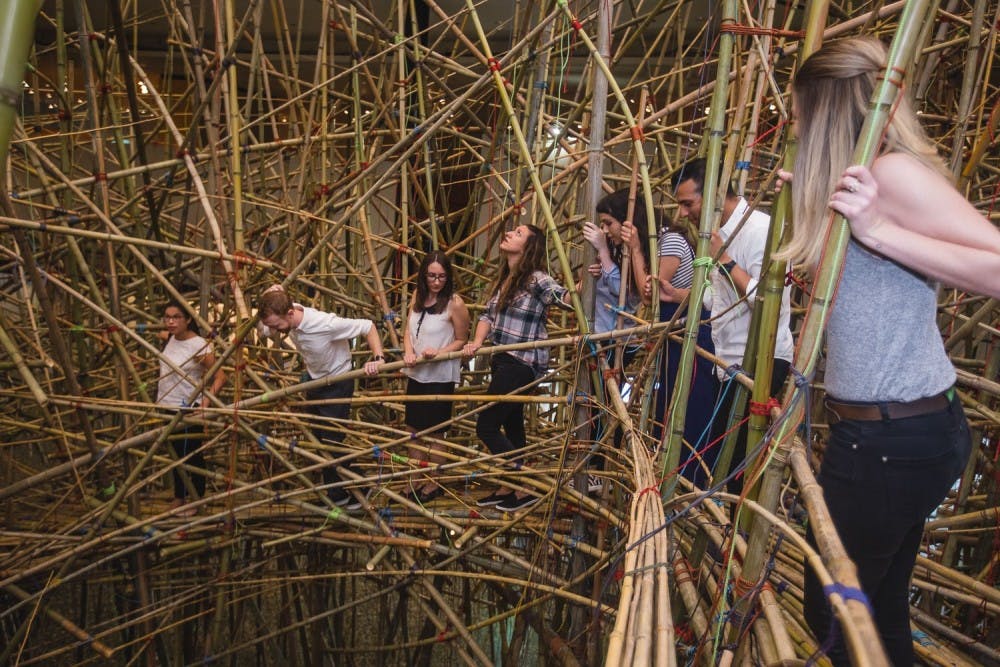“Big Bambú” exhibition celebrates the beauty and dynamics of natural design

Visitors gaze up at the bamboo installation, composed of 3,000 individual sticks. Photo courtesy Museum of Fine Arts, Houston.
In their installation for the Museum of Fine Arts, Houston, “Mike + Doug Starn: Big Bambú,” the Starn brothers use 3,000 bamboo poles tied together with rope to depict a dynamic sea, described by the MFAH as “an emblem of great age, continually new and changing.” The size and complexity of the piece is certainly astounding, as bamboo stalks rise in a wave 30 feet above Cullinan Hall, a large single-room gallery space at the center of the museum, and crash into the Upper Brown Pavillion. Huge photographs of the Starns’ previous works hang on the walls around the installation, adding to the sense of immensity.
The identical Starn twins got their start in the art scene with their conceptual photography, primarily focusing on capturing light. They first began working with bamboo in 2010, with a unique installation at the Metropolitan Museum of Art in New York. That exhibit alone was visited by 600,000 people. Since then, they have continued making bamboo pieces around the world.
At Big Bambú, visitors are invited to weave between the bamboo stalks at ground level before heading up to the balcony. There, visitors can actually walk on the installation via a pathway, winding through sticks before reaching ground level once again. The bamboo shifts under the weight of visitors, adding to the dynamism of the piece. Simultaneously, visitors are reminded of the strength of nature as they stand on only bamboo and string. Used to tie the bamboo poles together, the lines of string hang down from the bamboo. Some visitors took it upon themselves to add their personal marks, tying the string ends into knots and introducing an additional interactive aspect to the exhibit.
While the artists intended for their installation to resemble a swelling sea, the stiffness of the bamboo leads it to more closely imitate a forest, especially when viewed at ground level. However, sea or not, the Starns’ creation succeeds in multiple aspects. Filling the entire space of Cullinan Hall is no easy feat, and Big Bambú not only fills but also interacts with the space in a unique way through its connections with the Upper Brown Pavilion Balcony. This unconventional use of MFAH space makes the installation a must-see for visitors seeking a refreshing take on the well-known building.
The exhibit is on view until Sept. 3, 2018 at the MFAH. Tickets are $13 with any student ID, and entry requires a waiver.
More from The Rice Thresher

Acting like an athlete: Rice basketball alum takes on Broadway
Underneath Chadd Alexander’s Broadway costume, there’s ankle tape and wrist braces — same protective gear he wore as a walk-on basketball player at Rice, though now he’s performing eight shows a week in the ensemble of “Harry Potter and the Cursed Child” instead of running conditioning drills in Tudor Fieldhouse.
“Love Island” Season 7: A Messy, Magnetic Reality Show
It was my first time watching “Love Island,” and I get it now. There's a cycle to this show: you swear you won't get sucked in, you dismiss it as background noise, and then, one week later, you're canceling plans just to hear a group of twenty-somethings debate the meaning of the word "exploring." The truth is, “Love Island” has plenty of flaws. It’s too long, too produced and too ridiculous, but I'll be the first to admit it: I'm already planning to watch next season.
Review: “F1: The Movie” puts pedal to the metal
Joseph Kosinski, Claudio Miranda and Jerry Bruckheimer — the trio behind “Top Gun: Maverick” — return to high-octane spectacle with “F1,” a sports drama that blends spectacle with surprising humanity. It’s loud, stylish and frequently overwhelming, but it’s also one of the most engaging racing movies in years.


Please note All comments are eligible for publication by The Rice Thresher.